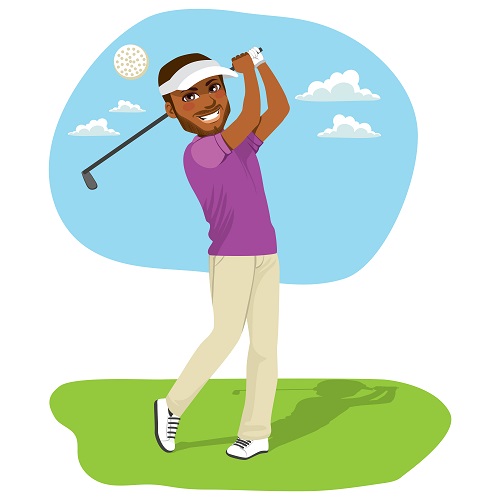17 Golf Tips for Beginners
Tired of watching your golf ball sail into the woods or dribble along the fairway?
As a seasoned golf coach, I’ve seen it all.
I’m here to tell you that those frustrating mistakes you keep making? They’re fixable!
This guide reveals 17 powerful golf tips to help you break bad habits, improve your swing, and unlock your true potential on the course.
Get ready to say goodbye to those embarrassing shots and hello to lower scores and more confidence.
Let’s get started!

Don’t have time to read the whole guide right now?
No worries. I can send you a digital copy so you can read it when it’s convenient for you. Just let me know where you’d like me to send it to (takes 3 seconds).

CHAPTER 1
Maximize Learnings From Others
Tiger Woods famously received a putting tip from his fellow Tour player Steve Stricker, which dramatically improved his putts that season onwards.
A few weeks ago, a golf friend of mine pointed out to me how I would put the golf ball too close to my putting stance.
That simple pointer changed how I putt, and even to this day after so many years, I have never forgotten this piece of advice.

I didn’t realize back then – but this was the cause for the inconsistency of my putts.
If you read around, you will see that there are so many stories like this, how even a pro player improved by hearing a small tip.
Takeaway: 2 Elements That Reduce Progress For So Many Players

No one is around to give out pointers and tips.

The player might get advice, but he shook it off and never put it into practice.
That is such a shame.
Let me tell you this:
If someone gave you any pointers or tips, do it at least once.
Worst case scenario, it doesn’t work for you, and so be it. It will only waste a fraction of your time.
The hard part is to be able to differentiate between good tips and bad ones. Not all tips will work for you, your play style, or your current abilities.
This is admittedly the hard part, as bad advice can build bad habits, which in turn builds bad performance.
This is the mission for me to write this article. I have compiled some of the most useful tips I’ve known over the years.
I’ve tested it myself, and I’m absolutely sure that they will be easy to apply to your game, and it will help you one way or another to improve your overall score.
I will divide these tips in four parts: the long game, the short game, your stance, and your health.
Each part, in my opinion, is equally important, and remember: please do give them a try at least once. It won’t hurt.
It’s also essential to expose yourself to other golfers. Participating in fundraising golf tournaments is one way.
As a coach, I always teach that the most valuable golf tip for competing at the highest level, a level faced by Shubhankar Sharma as he qualified for the Paris Olympics, is to stay patient and trust your fundamentals from the first tee to the final putt.
CHAPTER 2
Long Game Strategies
As a golfer, what drives your adrenaline is seeing – or even better, doing – a well-struck drive.
It is a well-known fact that modern golf game has evolved to be more distance and power-oriented.
Producing enough power to achieve the desired distance requires finesse and technique by itself, and that is why some of these tips might enlighten you.
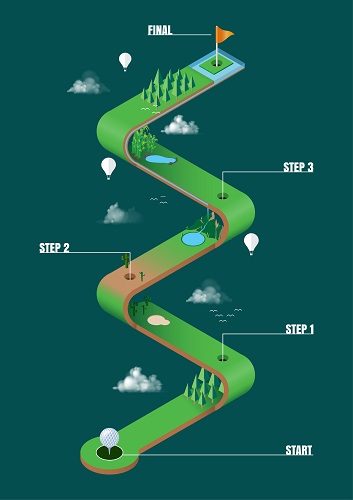
Tip #1: The Secret Of The Iron Game, Your Knees
A lot of us might emphasize our arms, back, and shoulders for the long game.
It’s not a wrong approach. However, there are differences between a teed-up golf ball for driver shots and when the ball is on the ground for your irons.
What Do The Pro Players Say?
Rory McIlroy, one of the stars of this generation, gave us a very solid tip to address the iron shots.
He suggested moving your weight down and forward as you make your swing, allowing the bottom of your golf swing to be angled in front of the ball.
To move that weight, drive your left knee toward the ball, and straighten it as you make your full swing.
On the other hand, Butch Harmon also suggested pushing your right knee to your left knee as you swing to make a proper shift of your weight forward.
Butch said that one common mistake of iron shots is that we might try to lift or chip the ball, instead of trying to hit it down and through.
By pushing your right knee toward the left knee and striking the golf ball with the back of your left hand facing the ball, you can eliminate the issue of trying to chip the ball.
One easy way to align your iron shot is to put your chest directly on top of the ball at impact. Combine all those, and see how your left knee game will affect your irons game.
If Rory McIlroy and Butch Harmon agree, it’s hard to make a pass for this tip.
Tip #2: The Wind Is Your Friend

For the long game, the wind is definitely your ally.
It is obvious that we shouldn’t try to fight the wind to achieve the desired distance.
Yet, many players still make the same mistake: swinging too hard.
Contrary to popular belief, you should make an easier golf swing to make the most of swinging downwind instead of harder.
Again, Butch Harmon contributed a great tip for this issue. He suggested to first things first:
Emphasize on hitting the ball solidly instead of embracing the urge to swing harder.
Buch Harmon
When you swing too hard into the wind, you will generate more backspin and send the ball higher, which in turn will sacrifice your distance.
Take an inch further back from your usual position, move your center of gravity a little lower by squatting a bit, and swing at 75%.
The idea is to delay your impact. So, to summarize, here are the steps to do it:
#1: Tee the golf ball roughly an inch higher
#2: Move the ball 1 inch further compared to your normal stance
#3: Be patient and swing easy. Focus on well-struck hits instead of swinging harder.
Butch Harmon also suggested taking more clubs during windy situations and trying to stay more on top of the ball during impact.
Remember, the key to making the wind your ally is to delay impact and give more room. It is also the same when you play a fade or draw, give more room to turn, and expect exaggeration on any curve.
Patience will give you more benefits, and less is more.
Tip #3: Imagine Hitting A Second Ball
Most golfers emphasize on what they do before the impact to make a powerful swing.
While it is not wrong, it is also not completely correct, and many golfers, even veterans, often make the mistake of neglecting the importance of the after-impact.
What’s worse, sometimes these habits happen unconsciously.
Many golfers have the tendency to quit at impact by pulling the club too quickly without realizing it.

So, the first thing to do is to evaluate your habit:
Do you have the tendency to break down your wrist and pull the club during impact?
If yes, you are definitely not alone! The first step in fixing the issue is admitting it.
To fix this habit:
You can visualize having a second ball, roughly 20 inches in front of the ball, and placing it on a straight line between the ball and your target.
As you make your swing, try to hit the second ball after you have hit the first one. To familiarize yourself, you can even use an actual second ball during your practice swings as an exercise.
As you build the muscle memory for this habit, you will improve your extension after impact. In turn, this might greatly improve your distance gain.
One thing to remember is to try to hit both balls solidly and maintain your rhythm and form for both balls, imaginary or not.
Remember, power is not the only thing driving distance, finesse and accuracy will also affect your distance gain considerably and your overall score.
Tip #4: Dustin Johnson’s Secret Rhythm

Dustin Johnson, the current world’s number 1 golfer, is known for many things, including his quite troubled past.
Personal life aside, he has a godly swing speed and an accurate short game, but most importantly, he has a unique, exquisite motion rhythm unlike any other in the PGA tour nowadays for his long game.
To achieve that swing rhythm, Dustin had a very simple trick: as you are preparing for a swing, bend your wrists toward the ball a little.
This is called triggering your swing, and many players had similar, albeit slightly different ways to trigger their motion.
The objective of this? Build muscle memory so that you can maintain rhythm throughout your swings.
One thing to remember is that no matter what trigger you use, you should keep the clubface closed at all times.
Opening the clubface will build a tendency to slice the ball. Choose your trigger, keep your rhythm, and maintain a proper, solid hit.
You will be surprised how your form will affect your distance gain, as well as the straightness of your ball.
CHAPTER 3
Short Game Strategies
While the long game is about power and distance, the focus on the greens will shift.
For the short game, the emphasis will be on finesse, technique, and accuracy.
The vast differences between the short and long game are the beauty of golf as a sport.
It is the cause of the diversity of play styles between players, creating a richness few other sports can match.
Some might say that building finesse and precision is harder than building your body for your golf swing speed.
We don’t completely agree, but it’s true that building finesse could be hard if you don’t know the right pointers.
Hence, we feel that these following types might help a lot of you, regardless of your current abilities.
Let us start with the first one.
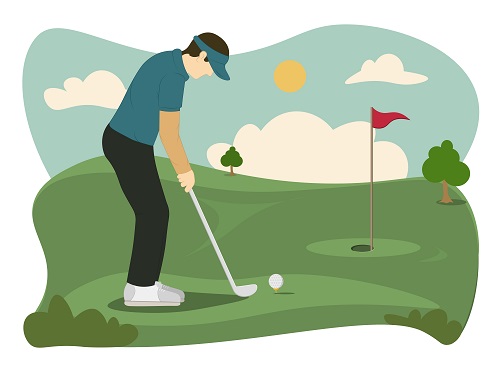
Tip #5: Get An Eye Exam

Although this tip is seemingly an obvious one, many of us overestimated our ability, especially regarding our eyesight.
In fact, many golfers don’t realize that they cannot perceive depth correctly, which in turn will affect their ability to judge the distance to the hole.
Pair that with the fact that during putts, we often focused more on breaks and directions instead of distance.
How Important is Eye Sight During A Game Of Golf?
Distance is an important factor: many golfers perceive the hole closer than it actually is, and it is actually more common than you think.
In the worst of cases, the error rate can reach 25 percent, meaning you misjudge a 12.5 feet distance as 10 feet.
Do you often wonder why your putts didn’t reach the hole when you were absolutely sure they should have? Your eyesight could be the culprit.
The obvious advice is to get an optometrist to examine your eye, but you can also do a simple DIY test to determine whether or not you are depth-deficient.
Step 1: Pick any object at least 20 feet away from you. You can use an actual hole for this.
Step 2: Focus on that object – or hole – and burn it deep into your mind’s eye.
Step 3: Close your eyes and point both of your index fingers to where you think the target is located.
Step 4: Open your eyes and examine whether or not you pointed your finger correctly.
This test can also serve as an exercise.
Keep practicing it with different objects until you can get it right consistently.
Tip #6: Perfecting Short Off A Tight Lie

Shorts from the tight lie or short grass can be the most challenging for beginners and veterans alike.
Whether it’s a short chip shot or a pitch shot, you will definitely benefit from more practice swings and a good old tip!
The best way to hit a really short grass, or when there’s not much of it, is to play it farther back. The tighter the lie is, the farther back your stance should be.
Try placing the club head behind the ball only with your right hand. Then, step in with your right foot as you set your ball, lining the ball with your instep. Set your left foot into a narrow stance as you complete your grip.
Your weight should favor your front foot, with your club shaft leaning forward.
Remember, the focus of your golf swing should be hitting the ball first instead of the ground.
What is the best way to achieve this? Practice and more practice.
As a simple exercise, do practice swings, assuming the golf ball is there. Make a habit of letting the club skim the ground and avoid digging.
The key is a narrow stance, and don’t let your hands go too far in front of the club head.
Tip #7: The Sand Wedge Putt
Lee Trevino popularized the use of the sand wedge for putts back in the 70s.
Nowadays, you can see almost every pro player uses the sand wedge putt.
This can be a play quite intimidating for beginners.
In fact, there are very few amateurs that I’ve seen giving it a try.
It’s a shame since the sand wedge putt can definitely be a nice addition to anyone’s arsenal, and it is actually not that hard to pull.
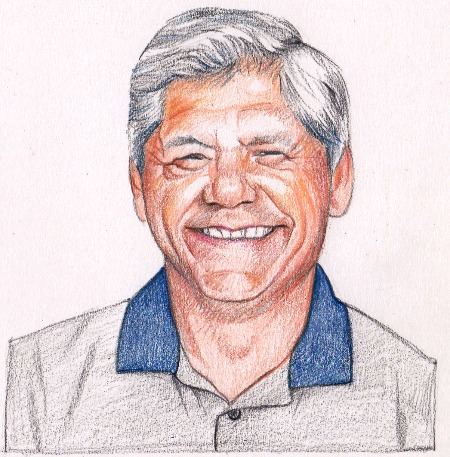

It is especially useful when your ball is just off the edge of the greens or in a light rough. It can also be useful when your ball sits on the outer edge of the fringe and is backed up against the rough lie.
In this unique situation, you would often want to get the golf ball rolling at all costs, but yet the flat blade of your putter might have trouble gliding through any grass taller than the fringe.
This is where the sharp and heavy club face of the sand wedge can fill the void. It will cut the grass easier and sharper, giving you the desired roll.
Pro Tip: Understanding the difference between putter and sand wedge
When using the sand wedge, it is very important to understand the difference in power compared to your putter.
The sand wedge will add more power to the impact, and thus you will need some practice swings to understand the differences in distance and to get used to the feel.
The swing weight of a sand wedge and a putter is roughly similar, so you would not need to adjust a lot.
You should also keep your putting grip as usual. Use the leading edge of the sand wedge to strike the back of the ball, which will usually translate to a harder grip by a little.
This is where practice swings come into play, but don’t be afraid to try it.
As you build your comfort with the sand wedge during these situations, you will find that you will eliminate a lot of risks when using the putter.
Tip #8: Picking Clubs That Are Matching My Play Style
The rule of golf allows you to carry 14 different clubs for a reason: to be able to tackle various situations on the course.
Yet, many players are often confused about which situation deserves which club, and in turn, cause reluctance.
It is easy to differentiate between when to use a putt and when to use a driver, but it’s not so obvious for using different irons and wedges.
Here, we will provide some tips that are easy to apply regarding the situations.
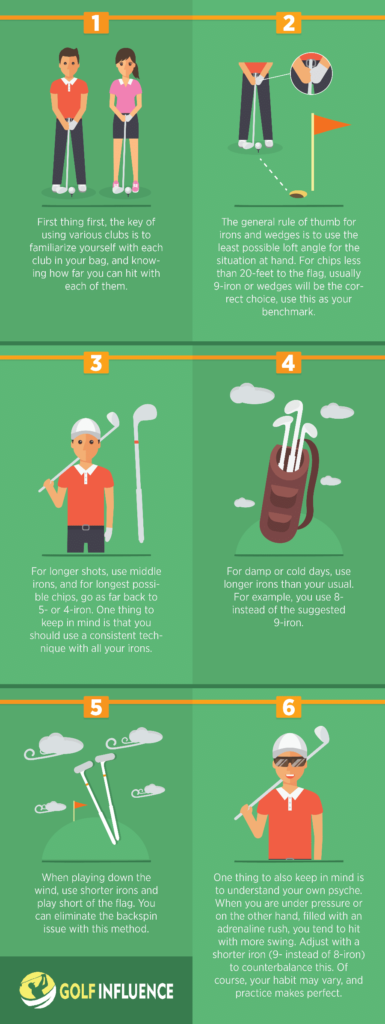
Tip #9: Putt Like Tiger Woods
Tiger Woods once shared how Steve Stricker, his friend and one of the best putters on PGA back in the days, shared his putting secret. In turn, Tiger shared it for you:
The secret of Stricker’s putt back then is his square stance, as well as the left-hand brush through the ball.
Tiger Woods
Stricker arguably made Tiger a better putter by squaring up his once too open stance and smoothing Tiger’s tempo with the left hand dictating the stroke.
Tiger back then often practiced exclusively with his right hand and he fixed his rhythm by practicing strokes with only the left-hand, which you should also try – it is something you can try at your local golf school, such as Bird Golf Academy.
Also, Stricker’s putt secret is how he smoothly just brushes the ball off the grass instead of rapidly hitting it (like how Tiger did back then).
Key Takeaway
The key to a successful putt is a smooth rhythm from start to finish, not strength.
Think of your putts as a brush stroke.
Tiger Woods improved his putts back then with this advice, and you surely can also improve now.
CHAPTER 4
Finding The Right Golfer’s Stance
Some might say that the secret for a great golf swing is the stance, and we absolutely agree.
Having a proper stance is like how sprinters have a proper starting position, which undoubtedly is a major factor of success.
Arguably, however, fixing a golfer’s stance is harder than it sounds.
While stances and habits can vary from golfer to golfer, there are some basic tips that can act as the holy grails and can easily be applied for any playstyle.

Tip #10: Keep Your Hands Low
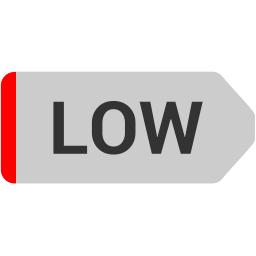
Keeping a lower position for the hands will lower the angle of the impact, which in turn, will limit the height of the follow through.
This is especially important for drives and faraway shots when you want less flight trajectory to achieve more distance, but you can build this habit for any shots to achieve better overall distance.
Many amateurs and younger players of this modern era often forget that basic tip and instead opt to use a stronger club to achieve the same effect.
You can also move the golf ball back in your stance to change the impact angle, but it is arguably more difficult and less reliable.
Pro Tip: How Low Should The Hands Go?
Adjust them until you can feel that the club heel is going to dig into the turf right before impact.
This is especially true with irons. Pull your left arm across your chest from the top through impact.
No, you will never physically dig the turf with the club, but visualizing it in your mind as you swing will help you maintain that low-hands position as you make the inside approach.
By keeping your hands low, you also have more room to sling the head through the ball, and that’s another secret for more distance.
Try to build a habit of keeping your hands low in the finish, and see how it will affect your trajectory (and distance).
Tip #11: Use Your Body For Power
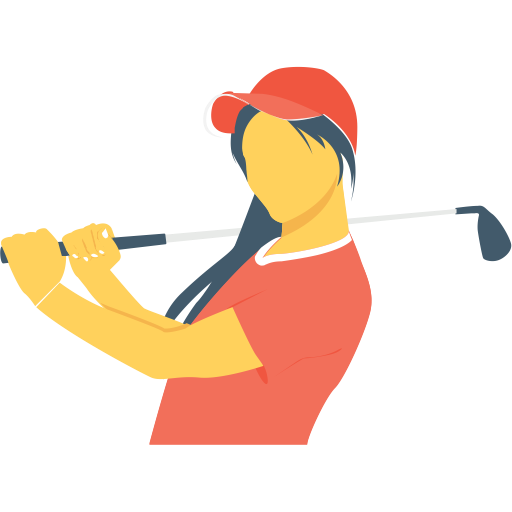
Here is another common misconception: the secret for golf swing power and distance is not your arms but your whole body swing.
Yet, it is one of the examples of easier said than done, mainly because so many golfers are confused about the concept of hitting with your body.
The secret is to keep your arms, hands, and wrist passive during your swing, directing your energy to your hips, legs, and torso instead. Your arms should only be used to control the swing.
Sounds confusing? Put it into practice and you will learn the secret in no time. Here is how:
Step 1: Try to find the correct ball placement where you would not need to reach or adjust with your arms.
Step 2: Use your wrist to move your club head backward. Feel how this move will decrease tension in your forearms. This is your starting stance.
Step 3: Move your club backward with your shoulders, keep your arms passive during the whole movement. You might not be familiar with this movement at first.
Step 4: Make your swing. Remember not to move your arms and wrists, even after impact. Let your arms separate from your body naturally, and use the momentum to help take your arms away from your body.
Step 5: Let natural momentum stop the swing, don’t use your arm muscles as it can strain them.
Also, throughout the whole movement, let your hips lead you, which in turn will create a more natural movement.
Let your hips drive your shoulders forward, which in turn will drive your arms to the golf ball. This is not only important to make a more powerful and effective golf swing but will also prevent injuries.
One common mistake is the wrist snap.
Observe your golf swing so that it won’t turn the wrist just before impact. This is a habit that is often subconsciously made, so if necessary, ask your friend or partner to observe.
Actively snapping the wrist, which will turn the forearms can create a hook. Let it turn naturally. Remember: arms, wrists, and hands should be passive throughout.
Tip #12: Aim Above and Below
In almost all golf lessons, you would be taught to always aim at the flag and adjust your body alignment with it.
It is not wrong advice, but I personally feel that there is a better way that you should definitely try: try observing what’s above and below the flag.
Try finding a focal point on the horizon above the flag. It can be a tree top, mountain top, anything.
It can even be an audience standing in the gallery behind the green. This method will especially help when you are not playing the golf ball directly at the flag.
The object will help hold your concentration and make it easier to align your body.
The fact that we have grown too familiar with the flags – which always look the same no matter what can disturb our concentration subconsciously.
This is why choosing another unfamiliar and distinctive spot can actually help your concentration.
Then, see what’s below the horizon.
It can be discolored grass just in front of you, a fallen leaf, or anything that is aligned to your earlier spot above. See if this simple method will help you align your body better and make a more accurate shot.
In fact, this tip comes from no other than Jack Nicklaus himself.
Remember how he is very consistent in aligning himself? I think it is safe to say that to this day, he is still one of the most consistent and accurate players on Tour.
Can we trust his advice then? Definitely!
Tip #13: Walk Smart, Play Smart
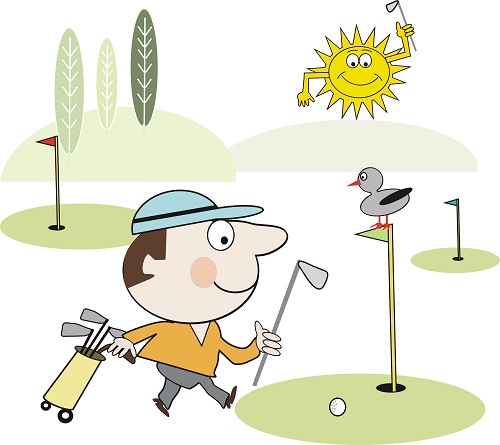
You might wonder how the Tour players maintain their concentration throughout their rounds.
Let’s face it, maintaining concentration for more than four hours is an extremely hard task for anyone, even for Tiger Woods or Jack Nicklaus. What is actually the secret?
You may guess from the title of this part: it’s the walk.
The walk between shots allows your mind to rest from thinking about golf. Some players might also use it to think about the next move, or you can also do a combination of both.
Pro Tip: How To Enjoy Your Walk On The Golf Course
As you start your walk, you can let your mind wander to all the pleasant things in life: your family, your next vacation, your kids, anything that will switch your brain from golf to non-golf.
As you reach the 40 yards or so mark, you can start analyzing the situation. Use this time to analyze the wind speed by looking at the trees, get a feel of how the ball will roll by looking at the greens.
Use this time wisely, but don’t let stress build up. Let it flow so that when you actually get to the ball, you are well-rested, well-informed, and you can fully focus on the shot at hand.
Some players might delay this type of thinking and analyzing until they actually arrive at the ball. However, it will delay the play.
For beginners and most amateurs, it is wise to use the walk smartly before you reach the ball.
Tip #14: Improving Your Address Position
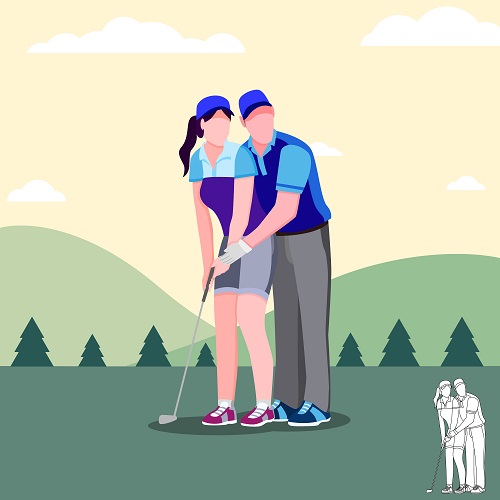
Do you have issues with how your putts roll? Do your putts easily roll off the desired line, or are they too weak to reach the target?
One of the most common mistakes causing this is the address position and how the angle of your putter is approaching the ball.
The ideal angle of the putter is either level to the ground or slightly rising away at the moment of impact.
Most weak dribbles happened because the impact is slightly down at the ball, creating a poor strike.
Also, many amateurs not only make the mistake of poor alignment but are also not consistent with their aim.
How can we fix these habits?
The first thing you can do is the most basic: set the golf ball a little more forward.
This basic theory of ball position will delay the impact, which in turn causes it to be level to the ground instead of hitting downwards.
To check the consistency of short putts, try hitting ten or more putts towards one hole. Leave all the balls in position.
Then, you can see the pattern of your shots and which side you tend to miss on. Realizing your mistake is the first step to fixing it.
Try fixing your address position for consistent putts with these tips:
#1: Keep your address position balanced. Meaning that parts of your body should be parallel to your intended target.
#2: At address, hold the top of the putter next to your left eye. Use the putter head to aim the ball. You should see the putter head directly on top of the ball perspectively. Try getting to this position consistently, it will improve your putts dramatically.
#3: Keep your stance comfortable. Hit the putt by tilting your hips with flexed knees. Your golf club should address the impact without your body getting in the way.
Tip #15: Move Your Weight for Slopes and Breaks
Why is it so hard to maintain consistent accuracy in golf?
Research suggests that it is because we are wired to see things at a higher level.
We subconsciously prefer flatness, and we judge distance, angle, and position based on that internal gyroscope.
That is why we often mis-aim our putter at address, while we are absolutely sure that it is a good read.
For example, when playing on a left-to-right slope, we have the natural tendency to lean with the slope until our eyes are level with the tilt of the green.
This often happens subconsciously, causing our eyes to shift outside, and in turn, will cause us to aim slightly to the left from our desired line.
The opposite will happen on right-to-left putts. We will have the natural tendency to miss to the right.
The fact that our shoes almost always feature heels that slope around two degrees further complicates the problem.

How, then, if it is our natural design, can we address the issue?
Simply observe your center of gravity and force your body to lean in the opposite direction of the slope you are standing on. This will help force the natural distortion of your inner gyroscope, but it will need practice.
Pro Tip: Shift Your Weights
The trick is to shift your weight into your heels on left-to-right putts and into your toes on the opposite side (assuming you are right-handed).
This simple posture change can greatly improve your putts in such situations and is definitely worth practicing.
CHAPTER 5
How To Take Good Care Of Your Health
For this last (but not least) part, we will talk about the final objective of golf: your health.
Health is not only an objective of the sport but also one of the best ingredients to maintain high performance on the course.
If you have worked hard to improve your game, upgrading your clubs, tried all the tips above, yet you still hit a wall, the problem might lie on your body condition and health.

Tip #16: Do The Most Important Stretches Before a Round: Shoulders, Lower Back, and Hip Flexors
A while back, we discussed several golf workouts and exercises that can help your flexibility and strength, which in turn will improve your performance (you might want to check it out).
In this part, we will also be talking about stretches, but it is designed to be done before a round starts.
Obviously, you will not have the time between rounds to do full body workouts and stretches, that is why let’s address the most important ones that can be done quickly and effectively.
Even better, you can do these stretches on one station, so you can think of it as a three-in-one stretch involving your regular towel and the golf cart.
The first stretch you should do is for your shoulders and lower back, both with one movement.
Shoulder flexibility is the most important factor for consistently powerful swings, and shoulder injury is also the most common during golf, due to the sudden explosive movement of the swing.
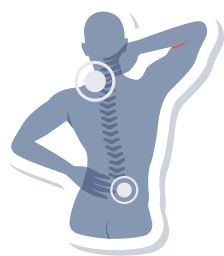
Lower back is important for a powerful swing, like we discussed above on how to use your body to make the swing.
Here is how you do the shoulder and lower back stretch:
- Twist the towel on a pole of the golf cart, hold it with both arms
- Stretch your arms straight as far as possible, bend your body down, your feet should be shoulder width apart
- Feel the stretch on your shoulders, hold for 30 seconds
- You can also lean slightly to the side to stretch your side muscles. Remember to repeat for the other side
Now, we move to the hip flexors, which are also important in maintaining a proper stance. To do the exercise, you can simply switch positions like this.
- Hold the towel with one hand, kneel on the ground
- Use the free hand to pull your feet towards your hip, hold position for 30 seconds
- Switch to the other side
These simple stretches will ensure your important muscles are properly fit before any rounds.
Tip #17: Laugh It Off

No matter how hard you have practiced, how focused you were, and how you commited to being better, you will always have a bad day on the course.
After all, it is the beauty of the sport, where nothing can be absolutely predicted.
Did your opponents score a miracle shot? Did you miss a great read? They happen all the time.
One thing to remember is that the golf should not cause you more stress.
One of the most important factors to improve is to maintain your passion for the golf game, and you do it by being happy while playing.
Pro Tip: Admit Some Things Are Out Of Your Control
There will always be certain things you cannot control. You will always hit the wall in performance. You will always see another player improving better.
What is the best way to face it? Shake it off and laugh.
Step aside from the game for a moment and take a deep breath.
Don’t let the miracle shot or bad miss haunt you for the next play. In this game, there will always be a loser, but nobody likes a sore loser.
The sooner you regain your concentration, determination, and composure, the sooner you will hit your best shots.
One thing to always remind yourself in such bad situations is that it is indeed only a game. There will always be another game and another day.
So, laugh it off and be happy.
CHAPTER 4
CONCLUSION
Now It’s Your Turn
I certainly hope some if not all of the tips will inspire you to get back on the golf course ASAP.
Give all the tips above a try at least once, and see if they work for you.
This is the beauty of the game, even the smallest change in how you swing, your stance, and how you address the ball can make a great difference.
Sometimes, I feel those who are lucky enough to be on the PGA Tour are simply those who discovered these secrets, either by discovering them themselves or hearing them from others.
